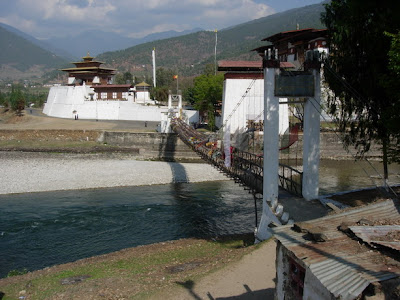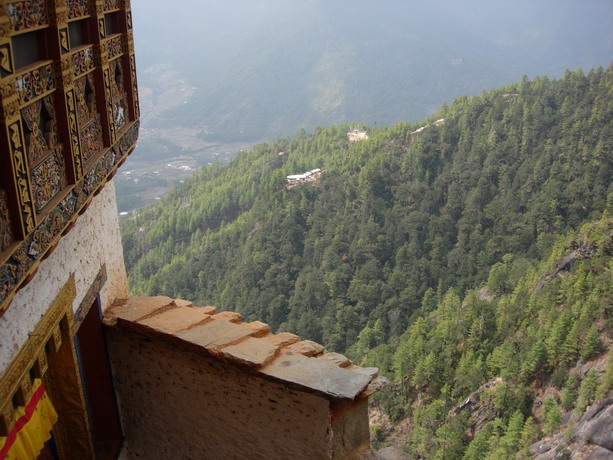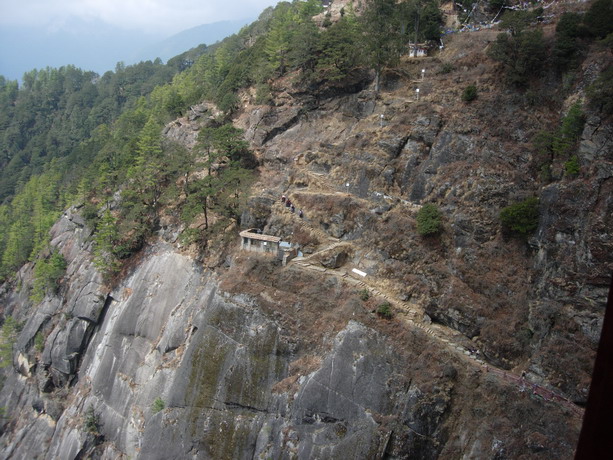“Good morning Your
Royal Highness, Ladies and Gentlemen, this is your Captain speaking, and I
would like to welcome you on board Druk Air flight blah, blah…”
I
seldom fly with Royalty, but there I was, flying out of Paro , Bhutan
In 1964, just five years before the United States Bhutan Tibet Tibet in
1959 was doubtless a significant motivator for Bhutan
Today
Bhutan
Although
it may once have been, it is not now a country of ascetic monks. On the other hand it has not embraced Western
style commercialism. Their present King,
Jigme Singye Wangchuck, in his cautious steps towards modernization and
economic self-reliance, has set Gross National Happiness as the measure for
growth rather than our measure of Gross National Product. Bhutan
Self-reliance
Sustainability
Efficiency and development of the
private sector
People’s participation and
decentralization
Human-resource development
Regionally balanced development
Fearing
they could easily be swallowed by either of their huge neighbours, most
Bhutanese appear to believe that cultural and environmental preservation is the
only way to protect their independence.
They willingly seem to accept the Bhutan Bhutan
So, by government decree, most people will be
seen wearing traditional dress, and certainly anyone remotely associated with
business or tourism would not be seen in western clothes. In the case of men, it is a long robe,
usually plaid, called a gho, which is
gathered at the waist to be worn knee length.
Women wear a floor length dress called a kira, striped, patterned, or brocaded. Many women, particularly those from the
villages, wear a lot of beaded and silver jewelry, similar to women from Tibet
Development has been slow and
measured. The first car arrived in the
country in 1962, and there are still only 2,000 kilometers of paved roads. The first tourists, 200 of them, were
admitted into the country in 1974. Last
year about 11,000 arrived. Television
and the Internet were introduced in 1999 (although Internet being dial-up, it
could be said that modern boon is still to come).
In keeping with their commitment to
their development goals, plastic bags are banned, and smoking has been all but
totally outlawed (in the week I was there I never saw a local smoking, and, in
fact, I saw only one tourist with a fag).
There is a national health care system and education is fully publicly
funded. I had a long chat with a young
guy working in a hotel who had been sent to the University of New Brunswick
The government intends to develop
tourism in the hope that that industry will make a major contribution to the
country’s economy. Although the official
language of Bhutan
Most
people fly in and out of Bhutan Bhutan , but for tourists there is only one road
available, the one built in 1964 and, which goes through the small city of Phuentsholing Darjeeling
to the Tensing Norgay Bus Terminal in Siliguri where I hopped on a bus to the
border city of Jaigaon Bhutan
In
the space of one step, I crossed from the unimaginable squalor of the Indian City
of Jaigaon into the quiet, order, and relative neatness that characterizes Bhutan
Traveling
in Bhutan
I
made contact with my travel agent by going to the official Bhutan Krishna , my driver with his 1991 diesel powered Toyota
Corolla.
With
two people to attend to my every wish (other than a change in itinerary) there
was not a door to be opened or closed, or a chair to be held that either
Thinley or Krishna were not there to do it for me, despite all my
protests. It was only when I started
opening and closing the doors for them that they finally got the hint.
Our first day’s drive took us from
Phuentsholing to the capital, Thimphu, a distance of only 172 kilometers with a
climb of over 2,000 meters, but which required a full six hours of steady
driving to cover. It also involved stops
at two police checkpoints where my travel documents were checked. This was a procedure that happened at least
twice every day, every time we entered a new sector.
As
soon as we left Phuentsholing, the road started to climb and twist, much of it
just hanging on the side of sheer cliffs, a pattern that was not to change for
all the miles we drove the next week. Oddly, Bhutanese promotional material
boasts that there is an average of 10 turns per kilometer on their roads. I could not disagree. All highways are simply a series of linked
curves, twists, and hairpin turns. The
roadway is much better than the one to Darjeeling Darjeeling
Speed Thrills But Kills
Don’t Gossip Let Him Drive
Control Your Nerves On Curves
Speed Is A Knife That Cuts Life
The
steep hillsides are regularly dotted with farmhouses, which from a distance
appear very much like chalets in Switzerland
In all of Bhutan
Not long after leaving Phuentsholing,
we saw electrical power cables running in every direction, evidence of the
other main industry in Bhutan India
On
arrival in Thimphu, I was checked into the quite new and perfectly comfortable
Hotel Riverview, which sits across the Wang Chhu (Wang River Bhutan
 |
| Butter Vendor, Thimpu Market |
 |
| Archery, the National Sport |
 |
| Recognizing a Bullseye |
Thinley
told me polygamy is not regularly practiced in Bhutan
Actually,
according to Thinley, the marriage ceremony in Bhutan
A
few years ago the first traffic control light in the country was installed at
the main intersection in Thimphu , but it was
taken out shortly after following complaints that it was ugly and
impersonal. The light was replaced by a
policeman who directs traffic during the day.
After his shift, drivers are left to sort themselves out. So of course, the Bhutanese boast of having
the only world capital without traffic lights.
My
weeks tour of Bhutan was
enough time to see the highlights of the country, and apart from its Buddhist
character, the most striking feature of Bhutan
In
all Bhutanese architecture there is a high degree of conformity with
traditional designs. Farmhouses, old and
new, are always three floors, the bottom floor houses the animals, the second
floor is where the family lives, and the top floor under the roof is open for
storage. They usually are decorated on
the front, particularly beside the doorway, with paintings of powerful symbols,
the chief one being graphic phallic symbols.
I
know I said in my letter on Thailand
The
most dramatic structures are the dzongs, a combination monastery and civic
administration facility housed within a fortress. There is a new Dzong in Thimphu ,
Trashi Chhoe Dzong, built in the 1960’s but it too is built in the traditional
style. My itinerary was set for me, like
I expect most itineraries are, to visit the most impressive of the ancient
ones.
From
Thimphu we traveled east over the Dochu La (Dochu Pass Bhutan
In
mid morning we stopped at a teahouse. As
I was to learn, at all our stops we were expected, everything was pre-ordered,
a table waiting, set for two (sometimes three if driver Krishna
was joining us), and often with a little card reading “ABC” (All Bhutan
Connection). One would not probably come
to Bhutan
Buddhists
are loath to kill animals. But they are
not vegetarians. This apparent dilemma
is easily solved by having the small Hindu population of the country carry out
the slaughter, and the Buddhists happily eat the kill. One meat dish often on the menu, and one I
was anxious to try, was pork with radishes.
I thought that sounded pretty interesting. It turns out the pork is pork fat, pork fat
with the hide, and often pork fat with the hide and hair. I took a pass.
Three
hours driving time and 75 kilometers from Thimphu ,
we arrived in Wangdi, site of the very impressive Wangdue Phodrang Dzong, built
in 1637. The dzong is draped on a ridge,
high above the Punak
River
Access
into a dzong is almost always through one massive door which leads to a rather
narrow passageway that makes two right-angle turns before entering the main
courtyard, a feature no doubt intended to slow invaders trying to enter. Always the left wing is the monastic side
with temples and monk’s quarters; the right wing is reserved for the civic
administration.
We
visited many temples on my tour, and at Wangdue Phodrang, as at all the
subsequent ones, Thinley would place a one meter by three meter scarf, called a
kabney, over his left shoulder,
ensuring that it draped just so. The
colour of the kabney denotes rank, and ordinary citizens like Thinley wore one
of unbleached white silk. At every temple Thinley
The road to the dzong wriggles through
the small town of Wangdi Krishna , they
both grew up here. Many if not most
shops, regardless of how small, declare themselves “General Store”. Inside these tiny shops one might find some
canned goods, toys, soap, shoes, yak cheese, dried fish, aspirins and apple
brandy. Slightly larger stores might
display a sign “General Store Cum Bar”, highlighting the broader range of their
services.
From
Wangdi we traveled some 20 kilometers to the town of Punakha Pho Rivers
The
next morning after spending the night at the Meri Puensum Hotel in a lovely and
comfortable cottage hanging on the side of the mountain, and with great views
of the valley and dzong, we headed further east over Pela Pass. Phobjikha
Valley Tibet
Our
destination for the day was further east to Trongsa, pretty much right in the
center of the country. As we crested the
Pele summit we were treated to rain, hail, sleet, and finally snow, weather
that seemed very appropriate given the 3,420 meters elevation.
Trongsa
Dzong, the ancestral home of the royal family, is the most impressive of all
fortresses in Bhutan Mangde River
There
are no ‘loops’ that one can do on a drive in Bhutan, all roads are just out and
back, so our next day was the long drive back from whence we had come, back
through Wangdi, Punakha, past Thimphu, to Paro.
Paro lies in a valley with the only flat land I saw, and hence it is the
location of the only airport in the country.
The
best had been saved for the last.
Another of Bhutan
However,
earlier in the day, at about 11:00 in the morning, I was at 2,900 meters,
drinking a cup of tea, and preparing myself for the final 400 meter ascent to Bhutan
Anyway,
the hike up to the teahouse had taken slightly more than one hour with an
elevation gain of some 500 meters. Even
though the next leg was much steeper, with quite precipitous drops alongside
the narrow trail, the spectacular sight of Tiger’s Nest as viewed from the
teahouse was more than enough motivation to carry on for one more hour.
After
leaving the teahouse, the trail followed a ridge, large mountain oak trees
draped in Spanish moss, pine, and rhododendron trees on all sides. Mist from the low clouds drifted through the
trees, it was quite magical. To get to
the monastery you actually have to climb up beyond it to cross a small stream
and then go back down, very discouraging, actually. There is a small gate a few hundred meters
before the monastery, lying beside it was a pile of firewood. On the gate was a hand-lettered sign,
Request
As saying goes “service to man is
service to God”.
Dear Brothers
& sisters we would like to request to get a piece of fire wood if you don’t
mind. Pl.
Thanks
by
Kings & Jam Som.
Well
of course Thinley and I had to make the last few hundred meters carrying
wood. And those last few hundred meters
are the most daunting, many visitors decline to go the last bit, satisfying
themselves with the views they have had getting to this point. The trail becomes stone steps that plunge
back down the rock face into a deep chasm, and looking down, it is very
intimidating. There is one last police
checkpoint just before the gates and then we arrived.
 |
| Don't Look Down! |
 |
| A Powerful Symbol |
I have again posted some photos. I do know this is inordinately, and most certainly unnecessarily, long but this was a very interesting week and there didn’t seem to be an easy place to split it up, so it all comes at once. Also, I have now been home for two weeks, I am obviously late getting this off, and it seems to me to be more a history report than a travel report. Nonetheless, I hope you enjoy it. I hope you are all well and have a great summer.
































No comments:
Post a Comment